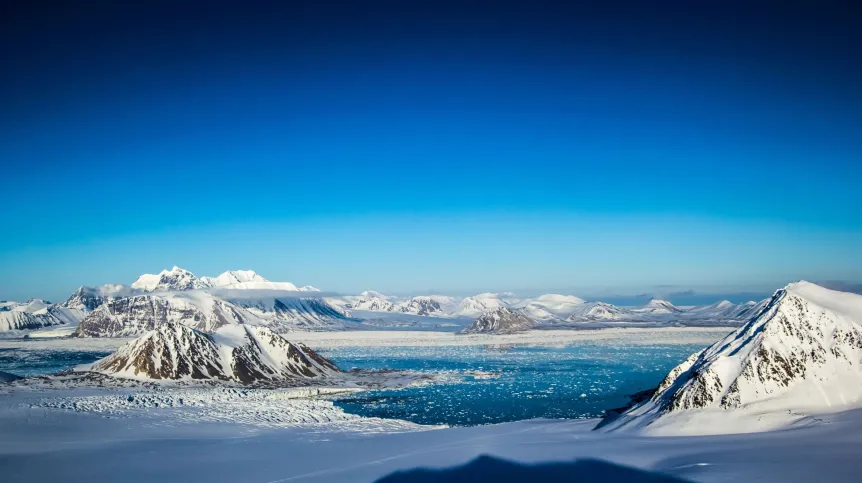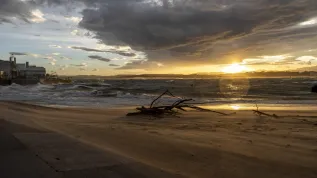
Recession, or the retreating glaciers, is one of the most visible phenomena in the polar regions. Scientists from the Institute of Geophysics and the Institute of Oceanology of the Polish Academy of Sciences have just completed field work in the project investigating its possible impact on changes in the Arctic ecosystem.
The project called 'RAW - Retreat and Wither - What is the influence of glaciers recession from tidewater to land-based on the marine biological production and biogeochemistry in the Arctic?' ended in April. Now researchers are performing laboratory analyses and measurements of the collected samples, and are working on publications that can be expected in the coming months.
As a result of climate change, the Arctic is heating up on average more than four times faster than the rest of the planet. This also affects the rate of melting of glaciers; as a result, glaciers that flow into the sea today are becoming land glaciers (i.e. they end on land, and the melting ice does not flow into the sea directly but rather through rivers).
The research team leader, Dr. Mateusz Moskalik from the Institute of Geophysics of the Polish Academy of Sciences told PAP - Science in Poland: 'Retreating glaciers are changing the environment of the polar regions, at fist by expanding the areas of the fjords, and in the long run by revealing new areas of land. As a consequence, the balance of nutrients in fjords changes, which affects the development of plankton and its role in absorbing carbon dioxide and depositing it in marine sediments. Whether these changes will be beneficial for us, i.e. their role in CO2 reduction will increase, or unfavourable, and their role will be smaller than currently - is not fully explored’.
He added that the project assumptions were based on observations of Greenland's fjords. 'However, in the case of the Spitsbergen fjords the situation seems much more complicated. This is due to the difference in the structure of the fjords in both areas. The Spitsbergen fjords are much shallower and have numerous bays fed by independent glaciers. In addition, these bays are usually separated from the main part of the fjord by an undersea ridge. The preliminary analysis of the measurements shows that in each of the bays, even those located near each other, there are different physicochemical conditions and, consequently, also different development of plankton’.
As scientists explain in the documentary Once the ice is gone directed by Kuba Witek, in front of the glacier flowing into the sea there is a phenomenon of upwelling, i.e. the carrying of masses of water rich in nutrients from the depths of the sea to the sea surface, where they mix with fresh water from the glacier. In this way, micronutrients transported by glaciers from land mix with macronutrients from the depths of the ocean, creating favourable conditions for the formation of marine plankton, which largely absorbs carbon dioxide.
'Retreating glaciers are changing the environment of the polar regions, at fist by expanding the areas of the fjords, and in the long run by revealing new areas of land. As a consequence, the balance of nutrients in fjords changes, which affects the development of plankton and its role in absorbing carbon dioxide and depositing it in marine sediments. Whether these changes will be beneficial for us, i.e. their role in CO2 reduction will increase, or unfavourable, and their role will be smaller than currently - is not fully explored', Moskalik said.
Fewer glaciers flowing directly into the sea inhibit this process, which may cause unfavourable conditions for the development of marine plankton in Arctic waters, and consequently their smaller role not only in CO2 reduction, but also in the functioning of other organisms in this region. This also means less food for the crowds of animals migrating there, including whales, birds and fish. This is important because the local zooplankton contains valuable fats, thanks to which animals are better prepared to survive the winter, Dr. Emilia Trzeciwska from the Institute of Oceanology of the Polish Academy of Sciences explains in the documentary.
Another aspect is that with the melting of glaciers (in general, without distinction between those flowing into the sea and those ending on land), more and more suspension is released into the sea, polluting the water and limiting the penetration of light. This results in worse conditions for plankton photosynthesis and plankton absorbs less carbon dioxide from the atmosphere. The more carbon dioxide in the atmosphere, the stronger the greenhouse effect, and the vicious circle closes.
In addition to examining the impact of retreating glaciers on ecosystems, it is also important to understand this process and monitor its course. This is the task of Dr. Oskar Głowacki from the Institute of Geophysics at the Polish Academy of Sciences. In his project financed by the Polish National Science Centre (SONATA competition), he researches new methods of studying ablation, i.e. the loss of glaciers at the border with the sea. 'These are passive acoustics methods. They involve listening to the sounds generated by the ice sheet underwater. Based on them, it is possible, for example, to assess the size of the detached part of the glacier that fell into the water', he says in the documentary.
In the future, it is also important to study the role of coastlines - the disappearance of permafrost, the reduction of sea ice and the increase in the number of storms result in increased coastal erosion and, consequently, the appearance of an additional source of suspended solids and nutrients. Work related to the impact of sea ice and waves is carried out under the supervision of Dr. Zuzanna Świrad from the Institute of Geophysics of the Polish Academy of Sciences as part of a project financed by the Polish National Science Centre (SONATINA competition).
Scientists from the Western Norway University of Applied Sciences were also involved in the research. The project was financed by the Norwegian Financial Mechanism 2014–2021 (GRIEG competition). (PAP)
PAP - Science in Poland, Agnieszka Kliks-Pudlik
akp/ bar/ kap/
tr. RL













